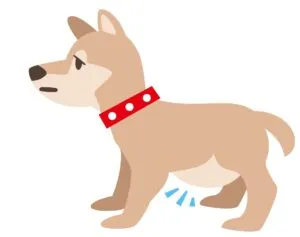Intestinal parasites are an unwelcome but often unavoidable aspect of pet ownership. These insidious creatures, varying in shape and size, pose a significant threat to your dog’s health and development. While many pet owners are familiar with the general concept of “worms,” understanding specific parasite symptoms, especially regarding questions like “Can Roundworms Cause Bloody Diarrhea In Dogs,” is crucial for timely intervention and proper care.
Roundworms (Toxocara spp.) are among the most common internal parasites in dogs, particularly puppies. They reside in the intestines and feed on ingested food, leading to a range of gastrointestinal disturbances. While a heavy roundworm burden can certainly lead to significant intestinal upset, including diarrhea and vomiting, bloody diarrhea is more commonly and directly associated with other types of intestinal parasites, such as hookworms or whipworms, or other severe underlying conditions. However, in exceptionally severe roundworm infestations, particularly in young or immunocompromised puppies, the intense irritation and inflammation of the intestinal lining could potentially lead to secondary damage, manifesting as bloody or mucousy stools. Recognizing all potential signs of parasitic infection is essential for ensuring your dog receives appropriate veterinary attention.
Roundworms and Diarrhea: What You Need to Know
Roundworms, resembling spaghetti in appearance, are acquired when dogs ingest infective eggs from contaminated soil, feces, or by consuming infected prey. Puppies can also contract them from their mother before birth or through nursing. Once ingested, these worms mature in the small intestine, siphoning nutrients and causing irritation.
The primary symptoms of roundworm infection often include a distended, pot-bellied appearance (especially in puppies), poor growth, a dull coat, and intermittent diarrhea. Vomiting is also common, and sometimes, the worms themselves may be visible in vomit or stool. While roundworms are highly irritating to the intestinal tract, they are not typically blood-feeding parasites in the way that hookworms are. Therefore, pure bloody diarrhea is less characteristic of a simple roundworm infection. If a dog with roundworms presents with bloody diarrhea, veterinarians will often investigate for co-infections with other parasites or bacterial/viral causes, or assess if the roundworm burden is so severe that it has caused extreme inflammation or secondary damage. Understanding how worms cause vomiting and diarrhea in dogs is vital for pet owners.
Common Signs of Intestinal Parasites Beyond Roundworms
Recognizing the signs of intestinal parasites is the first step towards getting your pet the help they need. While the specific parasite causing issues requires veterinary diagnosis, these symptoms indicate a potential problem.
Visible Worms in Stool or Around the Anus
Few things alarm a pet owner more than seeing worms in their dog’s stool. Roundworms, as mentioned, look like long, white spaghetti strands. Tapeworms (Dipylidium caninum) appear as small, segmented rice grains that may be found in fresh feces or dried and stuck to the fur around your dog’s anus or under their tail. These segments are actually packets of eggs that break off the adult worm.
 Dog worms in feces
Dog worms in feces
Diarrhea and Gastrointestinal Upset
Diarrhea is a very common symptom of various intestinal parasites. While roundworms can cause loose stools, other parasites are more notorious for causing bloody or mucoid diarrhea. Whipworms (Trichuris vulpis), which dwell in the junction between the small and large intestine and the colon, irritate the colon lining and frequently cause watery—often bloody or mucousy—diarrhea. Single-celled parasites like Giardia and Coccidia are also frequent culprits behind parasite-induced diarrhea, which can sometimes be bloody. The irritation, inflammation, and damage to the intestinal walls caused by these parasites prevent proper nutrient absorption, leading to weight loss and malnutrition, especially in young puppies and kittens. It’s important to understand if worms can cause bloody diarrhea in dogs to know when to seek immediate care.
 Dog suffering from vomiting and diarrhea
Dog suffering from vomiting and diarrhea
Persistent Vomiting
A dog with a significant worm burden can experience profound gastrointestinal irritation, leading to vomiting. In severe cases, a mass of adult worms can even block the intestine, causing a backflow of stomach contents. Vomiting is often seen alongside diarrhea, and sometimes, worms may be present in the expelled contents. It’s also worth noting that mild vomiting can occur as a normal reaction during veterinarian-prescribed deworming treatment, as the dog’s body eliminates the dying parasites.
Unexplained Weight Loss Despite a Healthy Appetite
When intestinal parasites like whipworms, hookworms, Giardia, or Coccidia damage the delicate intestinal lining, the body’s ability to absorb vital nutrients is severely compromised. This fragile, one-cell-thick tissue is responsible for absorbing nutrients from digested food into the bloodstream. When it’s damaged, food passes through largely unabsorbed. This results in pets eating ravenously yet still losing weight, as their body isn’t getting the nourishment it needs.
 Thin dog showing signs of weight loss
Thin dog showing signs of weight loss
Dull or Dry Coat
Your dog’s skin and coat condition are often a direct reflection of their internal health. When nutrient absorption is hindered by intestinal parasites, the haircoat often loses its luster, becoming dry, brittle, or noticeably dull. Attempts to improve the coat through dietary supplements or grooming products typically prove unsuccessful until the underlying parasitic issue is resolved.
Scooting or Licking the Hind End
Rice-like tapeworm segments, which are actually egg packets, can pass in your dog’s stool and cause uncomfortable itching and inflammation around the anus. This irritation often prompts dogs to scoot their hind end along the ground, drag themselves, or excessively lick the area to find relief. While other conditions like anal sac impaction can cause similar behavior, a quick visual inspection below your dog’s tail might reveal visible tapeworm segments if they are the cause.
Bloated or Pot-Bellied Appearance
Abdominal swelling or distention, often described as a “pot-belly” appearance, is a classic and common sign of roundworm infection, especially in severely affected puppies and kittens. In high-volume infestations, roundworms can become so numerous and large that they physically alter a pet’s abdominal shape. This distention can be painful and may lead to reduced appetite, vomiting, and, in extreme cases, intestinal blockages.
 Puppy with a distended, pot-bellied abdomen
Puppy with a distended, pot-bellied abdomen
Lethargy and Weakness
Infected pets often appear weak, fatigued, or have noticeably low energy levels. Puppies and kittens may not engage in normal play or interaction, preferring to sleep for extended periods. This parasite-induced lethargy can stem from ongoing nutrient malabsorption, dehydration resulting from severe vomiting or diarrhea, or anemia (a low red blood cell count), particularly in cases of hookworm infection. Hookworms (Ancylostoma spp.) are blood-sucking parasites with distinctive hook-like mouthparts that bite and feed on the intestinal lining. Their feeding can cause severe, life-threatening anemia, especially in young puppies and kittens. Since red blood cells are responsible for transporting oxygen throughout the body, anemic pets will visibly appear weak and lethargic.
 Lethargic cat resting
Lethargic cat resting
The Importance of Accurate Diagnosis and Prevention
While recognizing these signs is crucial, it’s important to remember that many symptoms of various intestinal parasites can overlap. Therefore, professional veterinary diagnosis is indispensable. A veterinarian can perform a fecal test to identify the specific type of parasite present and prescribe the most effective treatment.
Beyond treatment, ongoing prevention is key to keeping your dog healthy. This typically involves a regimen of monthly broad-spectrum flea and worm treatments and biannual fecal tests to monitor for infections. Strict hygiene protocols, such as prompt removal of pet waste and preventing dogs from consuming contaminated soil or feces, are also vital in reducing the risk of transmission. Understanding how worms are transmitted among dogs, including how worms can spread between dogs, can help pet owners implement better preventative measures.
Conclusion
The question of “can roundworms cause bloody diarrhea in dogs” highlights the complexity of parasitic infections. While roundworms primarily cause symptoms like vomiting, weight loss, and a pot-bellied appearance, a severe infestation can lead to significant intestinal upset. However, bloody diarrhea is more consistently linked to other parasites such as hookworms or whipworms, or potentially secondary complications in extreme roundworm cases. Observing your dog for any of these symptoms and seeking prompt veterinary consultation is paramount. Early diagnosis and a consistent prevention strategy are the best defense against intestinal parasites, ensuring your furry friend remains healthy and vibrant.
 Veterinary team providing care
Veterinary team providing care
